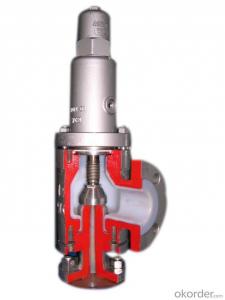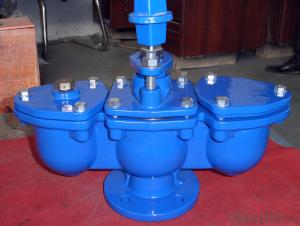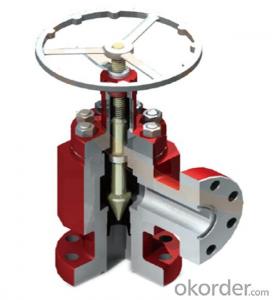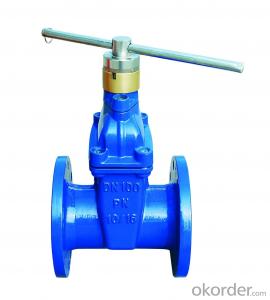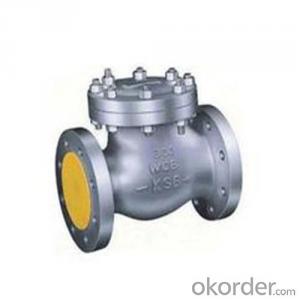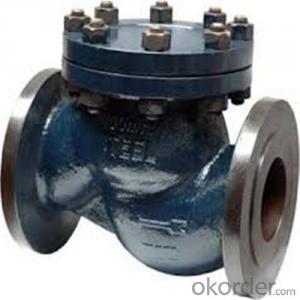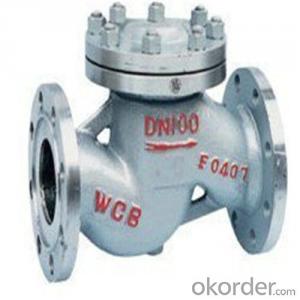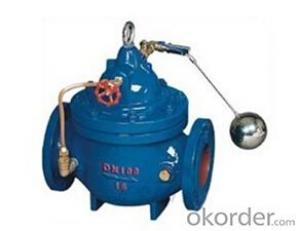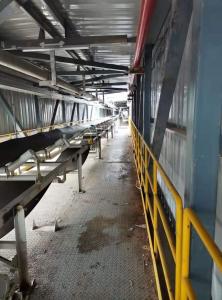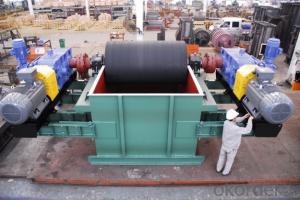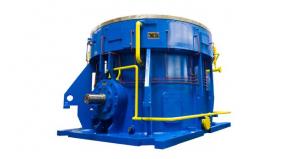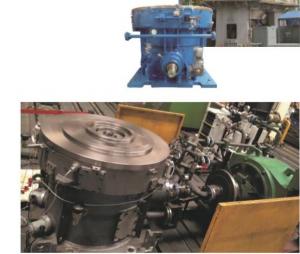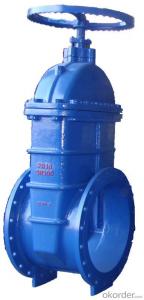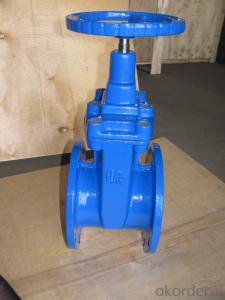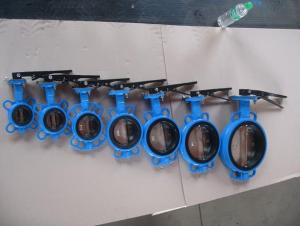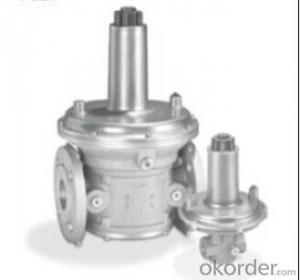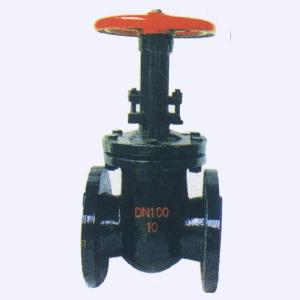High Performance High Temperature Relief Valve
- Loading Port:
- China Main Port
- Payment Terms:
- TT OR LC
- Min Order Qty:
- -
- Supply Capability:
- -
OKorder Service Pledge
OKorder Financial Service
You Might Also Like
Specifications
1. High Performance2. Competitive Price
3. Prompt Delivery
4. Perfect After-sale Service.
High Performance High Temperature Relief Valve
Product Information:
Manufactured according to ASME SECTION I
Size: 1 1/2" -- 6"
Pressure: 300LB -- 2500LB
Temperature: ±520°c
Product Feature:
The back pressure adjusting system utilizes the flowing steam to build and adjust back pressure, to ensure that lowdown is not more than 4% of set pressure.
Nozzle is welded with body, to make connection stable when it's serviced in the condition of high temperature and high pressure.
Connection of inlet and outlet is flange type, to make installation and maintenance easy.
Perfect guide design provides well alignment, to ensure that the operation of valve is agile and stable.
The selected materials are of high performance, which can be used in high temperature condition.
The nozzle and disc is faced with satellite, and lapped precisely.
Spring is produced through excellent technology, and tested under simulative service condition.
- Q:i have a leak on the front of that valve cover and the oil is going down to the headers,,how can i fix the problem.?how do i install da gasket do i need any special things??thanx for tha help
- its okorder /
- Q:Today I found out I have the heart disease Mitral Valve Prolapse. I'm 13, I weigh 109 pounds and I'm 5'8. I'm also pretty skinny too. I know this is a pretty common disease but should I be worried at all?
- Mitral valve prolapse is the most common cardiac problem and may affect five to twenty percent of the population. The condition is most common in women, although men are also affected. With MVP, symptoms do not begin before the early teenage years (approximately age 14 in girls and 15 in boys), but adults of any age may be affected. MVP tends to run in families, so those with blood relatives with MVP have a greater chance of also having the condition. If a person has mild MVP, he/she needs no restriction of exercise. But if the MVP is big, then it is a different thing. Because, though complications in this condition are very less, people who suffer from this condition have to take extreme care. In case of large MVP, you may have to cut down on your physical activity, have a surgery and may be put you on medications like beta blockers. If the valve is truly defective (not just 'prolapsed'), it is serious. Unfortunately, doctors have mistaken a 'differently shaped' mitral valve as a disease in itself. And this is where the non-disease comes in. In simple terms, a mitral valve that appears prolapsed is usually normal. It still is not clear to experts why some mitral valves appear prolapsed and allow some blood leakage backwards. I have an answer for that phenomenon, but the important point is that the disease is a non-disease.
- Q:I'm going to replace a valve guide and wondering how I should do it.Should I drill into the existing valve guide to the point it's small enough to pinch with some pliers and pull it out?When I put the new one in, should I use a wooden dowel and an air nailer to pound the guide into place?The more info. the better. It's my first time doing this.Thanks!
- Ohhhh man. NO DRILLS. I assume you are referring to an Aluminum Cylinder head. To do it correctly you need a drift punch that has a pilot size of the valve stem, and an outside diameter that is just a few thousands smaller than the guide. Disassemble the head completely, put in Moms oven at the highest setting it will go to ( 5-6 hundred degrees ) Pound old guide out from the combustion camber side. ( have every thing ready to go this FFer will be hot ). Coat new guide with something like STP, put in freezer, carefully align it, then slam it home from the valve train side, don't pussy around, get it in before it attracts the heat of the head, if you stop or it stops you will have to repeat the entire process. If you gall the Aluminum ( say O-**** ) Since you have to hit this thing fairly hard you will need to refinish the inside of the guide with the appropriate reamer. Then refinsh Valve seat ( they never, NEVER line up perfectly )
- Q:My car may have warped valves. What does this mean? Can it be fixed? If so about how much? And how does this happen in the first place? Anything helps! Thanks!
- Warped Valves? I take it you are talking about the engine? {May you mean Bent Valve Steams?} is the Head(s) apart and you have seen this? If it is Bent Steams there is no fix, Replace Valves Valve Guides. [Did some guess at this? the only real way to tell is have the head(s) off]
- Q:We have an oil steam system. There are Dole valves - 1A on each of the radiators. We bought new ones. They don't seem to be working. They look like a bullet shape with a screw in (on the side of the bullet) to the radiator. On the top of the bullet is a slit with numbers 1-10 on a dial. A picture we saw on the web showed a plastic piece of tubing in the screw part which looks like it goes into the radiator. If we remove the valve, the radiator gets hot with steam coming out of the hole. With the new valve on, the radiator barely gets warm. We're in Piscataway, NJ 08854. H-E-L-P.
- Seems to me that a steam valve would need to hold a lot more pressure than a hot water valve. Steam is a high pressure gas and water is a liquid irregardless how hot it is (below boiling point) I am not a qualified plumber or boiler tech but personally I wouldn't use a steam valve for water or vise versa.
- Q:also are those air flow limiting valves safe for the air pump to reduce the flow of air, I have one because the air bubbles are just way too many without one and it scares the fish away
- a check valve is to prevent back siphoning of water into the pump if you have a power outage or unplug the pump by accident. I'd suggest checking it by blowing through it the wrong way; if air does pass through get a new check valve (check new ones to be sure they don't limit airflow too much, and that the close in the wrong direction, many are cheap crap and don't work the day you buy them, so check them before you leave the store with it...note: same with thermometers, compare them with each other so you don't get the one that's crap) what you want is a normal air valve, they come in various configurations, one or more valves so as to run multiple airstones and to balance the airflow to each stone or ornament. You should not however just use the valve to limit airflow, as this damages the pump eventually. You can just let one of two valves bleed off a little air; however make sure another check valve is in the line from the tank to the valves or else you risk water coming out of that valve if it's lower than the tank water level.....You may want a smaller air pump or an adjustable one instead.
- Q:I wanted to clean my 2005 accord ex 2.4 idle valve. I'm not sure where it's at any pictures or websites ? And will cleaning it make any difference
- Probably won't help. Idle Air Control valves are blamed probably ten times as often as they are at fault in Honda engines. It is mounted on the side of the throttle body and has a connector with wires instead of hoses. You don't mention why you are interested in the IAC valve, but if it is because of idle hunting (revving between about 500 rpm and 1500 rpm smoothly and rhythmically), a bubble in the coolant is by far the most common cause. If the coolant is changed and not bled the normal idle speed can't get hot coolant to the Fast Idle Thermo valve (FITV) so it figures the engine is cold and the valve opens to raise the idle. That raises the coolant to the FITV, which then decides the engine is warm so the valve closes, dropping the idle speed, over and over. Burping the coolant, by opening the bleed nipple on top of one of the radiator hose housings at the engine half a turn until a steady stream of coolant comes out, should stop that. Do it with the engine cold.
- Q:heater control valve is leaking
- Do it from underneath. Drain the cooling system and cut the short hose between the heater core and the valve with a sharp knife. Unfasten the actuator cable, loosen the clamp on the heater hose and work the heater hose off it. Use the sharp knife to slice the remains of the short hose off the heater core... be gentle because the soft pipe is easily deforned (which is why you must not try to wrench it off). Put a replacement hose on the new valve and reassemble. When you refill the cooling system be sure to purge the air by opening the bleeder nipple on the upper radiator hose housing at the engine until a steady stream of coolant comes out. Watch out for the sharp edge of the catalytic converter shield! I have a scar on my wrist from learning that the hard way. EDIT - I forgot to mention - if the cable seems to be misadjusted on the valve when you are done, remove the passenger side of the console and look at the mixer linkage in there. The cable housings often slip in the clamps.
- Q:Can you please explain to me what an atrial valve is and what it does??
- You're incorrectly combining two parts of the human heart, atrium(atria) and valves. The human heart has four chambers, two superior ATRIA and two inferior ventricles. The atria are the receiving chambers and the ventricles are the discharging chambers. The pathway of blood through the human heart consists of a pulmonary circuit and a systemic circuit. Blood flows through the heart in one direction, from the atria to the ventricles, and out of the great arteries, or the aorta for example. This is done by four VALVES which are the tricuspid valve, the mitral valve, the aortic valve, and the pulmonary valve
- Q:I am trying to bench bleed my master cylinder on a 94 altima...the directions state to attach the bleeding hoses to the outlet valves?? I haver four valves that merely state front or rear??
- All hot water heaters have what they call Anode Rods For more than 60 years, it has been used as a key part of the rust protection of a tank. The rods are made of magnesium or aluminum that's formed around a steel core wire and is screwed into the top of the tank. A lot of the times they are on the hot water outlet. You should have a dielectric union separating the galvanized pipe on the top of the water heater from the copper pipe for your house supply. You should be able to remove the anode rod from the tank and get a replacement from your local plumbing supply store. Most likely the sediment/ hard water deposits have deteriorated the rod and have caused corrosive deposits to clog your lines.
1. Manufacturer Overview |
|
|---|---|
| Location | |
| Year Established | |
| Annual Output Value | |
| Main Markets | |
| Company Certifications | |
2. Manufacturer Certificates |
|
|---|---|
| a) Certification Name | |
| Range | |
| Reference | |
| Validity Period | |
3. Manufacturer Capability |
|
|---|---|
| a)Trade Capacity | |
| Nearest Port | |
| Export Percentage | |
| No.of Employees in Trade Department | |
| Language Spoken: | |
| b)Factory Information | |
| Factory Size: | |
| No. of Production Lines | |
| Contract Manufacturing | |
| Product Price Range | |
Send your message to us
High Performance High Temperature Relief Valve
- Loading Port:
- China Main Port
- Payment Terms:
- TT OR LC
- Min Order Qty:
- -
- Supply Capability:
- -
OKorder Service Pledge
OKorder Financial Service
Similar products
New products
Hot products
Related keywords
